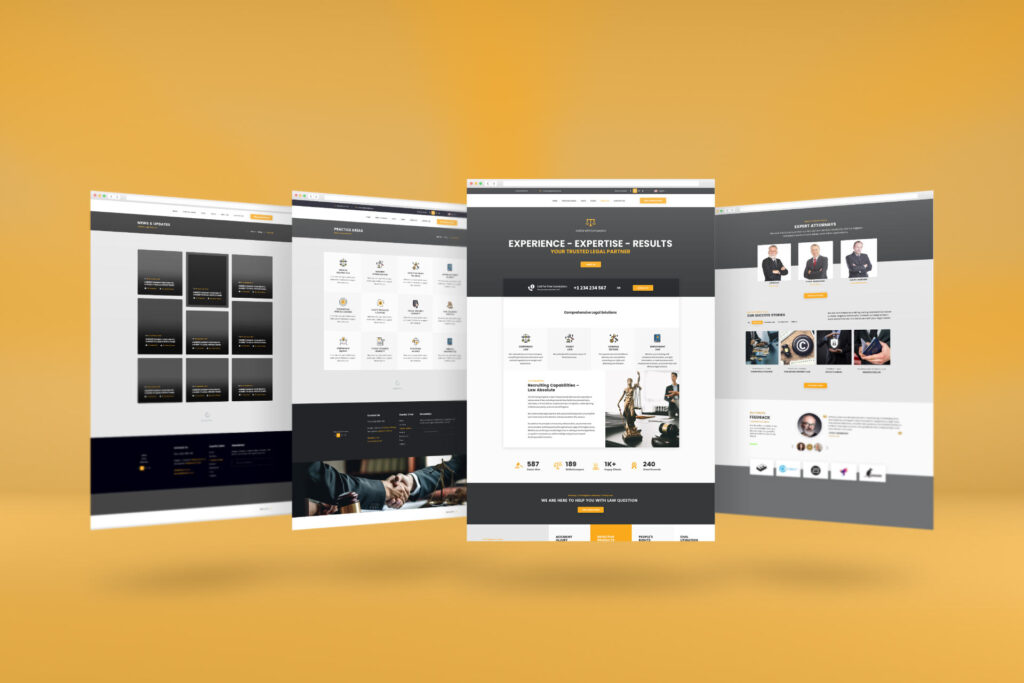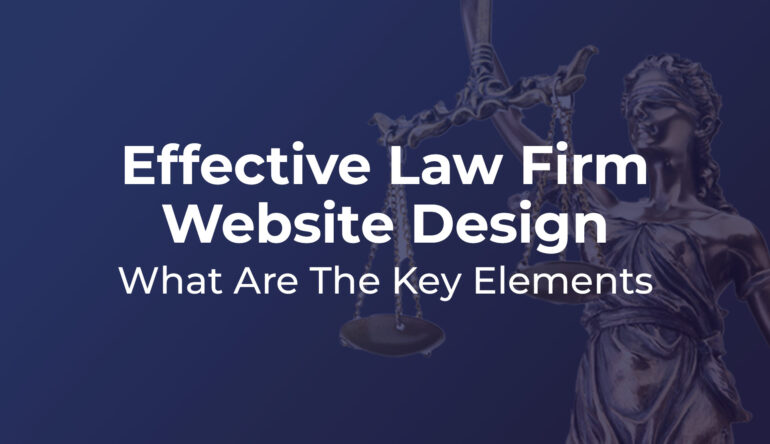In today’s digital age, a well-designed website is crucial for law firms to attract and retain clients.
However, creating an effective online presence involves more than just aesthetics.
For you to make an informed decision, we have made a list of key elements to look for when choosing law firm website design.
Who Should Read This Guide?
This guide is designed specifically for law firm owners, partners, and marketing professionals within legal practices who are responsible for their firm’s online presence.
If you’re looking to enhance your website’s performance, attract more clients, and establish a strong digital footprint, this article is for you.
Here are the key elements in law firm web design you should focus on:
- Choosing the right designer or agency
- Website content structure
- Usability of the design
- SEO
- User Engagement
- Technical and legal considerations
1. Choosing the Right Designer or Agency
Specialized Agencies vs. General Platforms
When it comes to choosing who will design your law firm’s website, you have two main options: hiring a specialized law firm web design agency or using general platforms like WordPress, Wix, or Squarespace.
Now, we will list the pros and cons of both approaches.
Specialized Agencies:
- Pros: They understand legal marketing rules and can ensure compliance. They also have experience with the specific needs of law firms.
- Cons: They can be more expensive than general platforms.
General Platforms:
- Pros: Cost-effective and user-friendly. They offer a variety of templates and plugins to customize your site.
- Cons: May lack specific legal industry insights and compliance features.
- Examples: WordPress is widely used due to its flexibility and extensive plugins.
Recommendations for Choosing a Designer or Agency

Vetting: When selecting a web designer or agency, it’s crucial to look for those with experience in the legal industry. Check their portfolio to see examples of law firm websites they have previously designed. Client reviews and testimonials can also provide valuable insights into their reliability and quality of work.
Long-Term Partnership: Choose a partner who can grow with your firm’s needs. Look for agencies that offer ongoing support and updates to ensure your website remains current and effective. A long-term partnership can provide continuous improvements, security updates, and SEO enhancements to keep your site performing at its best.
Introducing W3Lab’s Services: At W3Lab, we specialize in creating tailored websites for law firms that not only look professional but also drive results.
Our team of experienced web designers understands the unique needs of the legal industry and is committed to helping you achieve your online goals.
Here’s why W3Lab is the law firm website design company for you:
- Expertise in Legal Industry: We have a proven track record of designing websites for law firms, ensuring compliance with legal marketing rules, and creating user-friendly, informative, and engaging sites.
- Comprehensive Portfolio: Our portfolio showcases a range of custom websites we’ve developed, highlighting our ability to create customized solutions that meet diverse needs.
- Client Testimonials: Our clients’ positive feedback speaks to our dedication to delivering high-quality, effective websites that enhance their online presence.
- Ongoing Support: We offer continuous support and updates, ensuring your website stays current with the latest technology and SEO practices. This long-term partnership helps your firm adapt to changing digital landscapes and maintain a competitive edge.
By choosing W3Lab, you’re not just getting a website; you’re partnering with a team that is invested in your success.
Contact us today to learn more about how we can help you build a website that exudes trust and drives results.
Contact us to build a website that drives results
2. Structuring Your Website Content
Essential Pages and Sections For Law Firm Websites
A well-structured website is easy to navigate and provides visitors with the information they need quickly.
Pages that are a must for a lawyer’s website include:
- Homepage: Clear messaging about your firm’s expertise and services.
- Practice Area Pages: Detailed descriptions of each service you offer.
- Attorney Bios: Professional profiles of your team members.
- Client Testimonials: Success stories and feedback from past clients.
- Blog: Regular posts about legal topics to demonstrate your expertise and improve SEO.
Effective Content Strategies
Organize your content to ensure maximum engagement and easy navigation.
Successful law firm websites often include:
- Clear and concise messaging: Visitors should understand within seconds what your firm offers and how you can help them.
- Visual aids: Use images, infographics, and videos to make your content more engaging.
3. Design and Usability in Legal Websites
Professional Appearance
Law firm website design should reflect the professionalism and trustworthiness of your firm. Key elements include:
- High-Quality Images
- Consistent Color Scheme
- Clean Layout

1. High-Quality Images
Use professional photos of your office, team members, and events. Avoid generic stock images, as they can appear impersonal and undermine your firm’s authenticity.
Hire a professional photographer to capture images that represent your firm’s unique character and values.
2. Consistent Color Scheme
Choose a color palette that aligns with your brand identity and evokes a sense of trust and professionalism.
Common choices for law firms include shades of blue, grey, and white, but you should select colors that represent your brand.
Ensure that this color scheme is used consistently across all pages of your website, as well as in your marketing materials.
3. Clean Layout
Keep the design simple and uncluttered. Avoid overwhelming visitors with too much information or too many elements on a single page.
Organize content logically, using headings, subheadings, and bullet points to make information easy to find and read.
Make sure important information, such as contact details and services offered, is easily accessible.

Mobile Optimization
A significant portion of your website traffic will come from users on smartphones and tablets. Mobile optimization ensures that these users have a seamless and positive experience.
Here’s what to consider:
- Responsive Design:
- Implement a responsive design that automatically adjusts to fit different screen sizes. This means your website will look and function well on desktops, laptops, tablets, and smartphones.
- Test your website on various devices and screen sizes to ensure consistency and usability.
- User-Friendly Navigation:
- Simplify navigation menus for mobile users. Use clear, concise labels and avoid complex dropdown menus that can be difficult to use on smaller screens.
- Consider incorporating a search function to help users quickly find the information they need.
- Fast Load Times:
- Optimize images and other media to ensure fast loading times on mobile devices. Slow load times can frustrate users and lead to higher bounce rates.
- Minimize the use of heavy scripts and plugins that can slow down your site.
- Readable Text and Buttons:
- Ensure that text is large enough to read easily on small screens. Avoid using tiny fonts that require zooming in.
- Make buttons and links large enough to tap easily with a finger, and provide adequate spacing to prevent accidental clicks.
By focusing on these elements, you can create a professional, user-friendly, and mobile-optimized website that effectively represents your law firm and meets the needs of your clients. This will help build trust and encourage potential clients to choose your firm over competitors.
4. The Importance of SEO for Law Firm Website Design
In the digital landscape, Search Engine Optimization (SEO) is essential for increasing your website’s visibility and attracting organic traffic.
For law firms, an optimized website can significantly enhance online presence, drive client acquisition, and establish credibility.

Here are the key elements of effective SEO that should be included in the best law firm website design:
Technical SEO
Technical SEO focuses on the backend aspects of your website to ensure it runs smoothly and efficiently. Key considerations include:
- Speed: A fast-loading website is crucial as it reduces bounce rates and improves user experience. Studies show that users expect a website to load in under three seconds, and delays can lead to higher abandonment rates.
- Security: Ensuring your site is secure (HTTPS) not only protects your data but also builds trust with visitors. Google prioritizes secure sites in its rankings, making this an essential factor for SEO.
- Mobile-Friendliness: With an increasing number of users accessing websites via mobile devices, having a responsive design is critical. Google’s mobile-first indexing means that the mobile version of your site is considered the primary version, affecting your rankings significantly.
Content Development for Law Firm Website
Content Development involves creating and regularly updating your website with relevant, high-quality content. This is vital for keeping your audience engaged and improving your search engine rankings.
Effective law firm web content strategies include:
- Blogging: Regular blog posts on legal topics relevant to your practice areas not only provide valuable information to your audience but also signal to search engines that your site is active and authoritative.
- Keywords: Incorporating targeted keywords naturally within your content helps search engines understand what your pages are about and improves your chances of ranking for those terms.
- Client Testimonials and Case Studies: These elements provide social proof and build credibility. Detailed case studies showcasing your success stories can also improve engagement and SEO.
Off-Site SEO
Off-site SEO involves activities outside your website to improve its authority and rankings. Important strategies include:
- Google Business Profile: Maintaining and optimizing your Google Business Profile helps your firm appear in local search results and Google Maps, making it easier for potential clients to find you.
- Backlinking: Building high-quality backlinks from reputable sites signals to search engines that your website is credible and authoritative. This can significantly boost your search rankings.
- Social Media Engagement: Active engagement on social media platforms can drive traffic to your website and improve your online visibility. Sharing your content and interacting with your audience can also enhance your off-site SEO efforts.
At W3Lab, we understand the complexities of SEO services and their critical role in building a successful online presence for law firms.
Our team of experts is dedicated to implementing complete SEO strategies that ensure your website attracts traffic and converts visitors into clients.
Ongoing SEO Efforts
SEO is not a one-time setup but an ongoing process. Regular updates and maintenance are necessary to keep your website optimized and competitive.
5. User Engagement and Conversion Optimization
Effective Calls to Action
To convert website visitors into clients, your law firm website design needs to include clear and compelling calls to action (CTAs).
Here’s how to optimize for engagement and conversion:
- Prominent CTAs:
- Place CTAs like “Contact Us,” “Schedule a Consultation,” or “Get Legal Advice” in easily visible areas, such as the top of your homepage, at the end of blog posts, and on service pages.
- Use contrasting colors and bold fonts to make CTAs stand out, ensuring they catch the visitor’s eye.
- Strategic Placement:
- Position CTAs at natural stopping points where users might be ready to take action, such as after reading about your services or a compelling case study.
- Include CTAs in the header and footer of your site for easy access.
- Interactive Features:
- Integrate chatbots to provide instant assistance and answer common questions, guiding visitors towards scheduling a consultation or contacting your firm.
- Use contact forms that are easy to fill out, with clear instructions and minimal required fields, to capture leads without overwhelming potential clients.

Building Trust and Credibility Through Web Design
Building trust is essential in attracting and retaining clients. Your law firm website design should incorporate elements that demonstrate your credibility and track record of success:
- Client Testimonials:
- Feature client testimonials prominently on your homepage and dedicated testimonial pages. Positive feedback from satisfied clients can significantly influence potential clients.
- Include photos and names (with client permission) to add authenticity and relatability.
- Case Studies:
- Develop detailed case studies showcasing your firm’s successes. Highlight the legal challenges faced, the strategies employed, and the successful outcomes achieved.
- Use a storytelling approach to make the case studies engaging and relatable.
- Success Stories:
- Share success stories that emphasize the impact your firm has had on clients’ lives or businesses. These narratives can be powerful tools for building an emotional connection with visitors.
- Incorporate multimedia elements such as videos or infographics to make the stories more engaging.
- Professional Credentials and Awards:
- Display any professional credentials, certifications, or awards your firm or attorneys have received. This can include memberships in professional organizations, recognitions from industry publications, and other accolades.
- Place these prominently on your website to enhance your firm’s credibility.
Focusing on user engagement and conversion optimization in law firm website design, you create a more interactive and trustworthy online presence.
Clear CTAs and evidence of your firm’s successes will encourage visitors to take the next step, whether it’s reaching out for a consultation or requesting more information, ultimately leading to higher conversion rates and more clients for your law firm.
6. Technical and Legal Considerations
Ownership and Flexibility
It’s essential to own your website and its content, ensuring you can make changes, backups, and transfers as needed. Tips include:
- Easy Backups: Regularly back up your site to avoid data loss.
- Platform Flexibility: Choose a platform that allows easy migration if needed.
Avoiding Long-Term Contracts
Be cautious of restrictive long-term contracts with web design agencies. Negotiate flexible agreements with clear deliverables to ensure you get the best value for your investment.

Conclusion
Creating an effective law firm website involves careful consideration of design, content, and SEO strategies.
By choosing the right web designer, structuring your content effectively, and ensuring your site is optimized for both search engines and mobile devices, you can build a professional online presence that attracts and retains clients.
If you’re ready to take your law firm’s website to the next level, contact us today for a free consultation.





